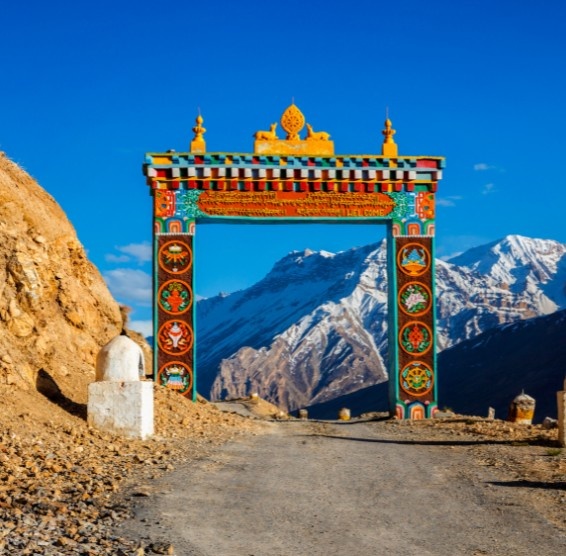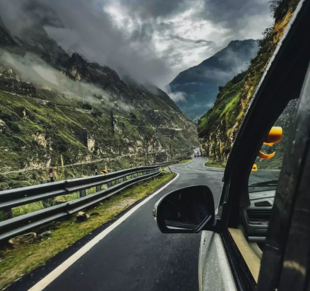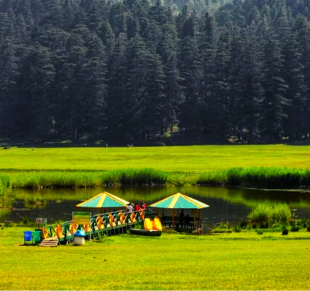A Complete Himachal Tour Guide: Exploring the Heart of the Himalayas
From snowy peaks to peaceful valleys — discover the best of Himachal, one place at a time.

Himachal Pradesh – Where Nature, Culture, and Calm Come Together
Himachal Pradesh is truly the "Land of Gods." It has snow-capped peaks, emerald valleys, and a rich cultural history. Think about how nice it would be to breathe in the fresh mountain air while pine trees whisper around you and friendly locals greet you at every turn. A tour of Himachal takes you to beautiful places and friendly people at every turn, from busy colonial-era towns to quiet mountain villages. This complete guide will show you the best of Mystical Himachal, including its famous sights, exciting activities, vibrant culture, and helpful tips for your first visit. Whether you're looking for thrilling adventures or peaceful isolation this guide has it all.
Top Destinations in Himachal
- Shimla – Queen of the Hills: Shimla, the capital of Himachal, is a beautiful old-fashioned hill station in the foothills of the Himalayas. Shimla is known for its historic colonial buildings and the Mall Road promenade. It has both nostalgic charm and beautiful scenery. Walk by the Christ Church or under the tall deodar trees at Jakhu Temple, all with the snow-covered peaks above. Shimla is a classic stop on any Himachal tour because it has a mix of history and scenery. The weather is nice all year round, and there are things to do like nature walks and winter sports in Kufri.
- Manali – Adventure Gateway: Manali is in the Kullu Valley and is surrounded by green forests, rushing rivers, and tall mountains. People come here to hike, ski, paraglide, and white-water raft because it is known as an adventure hub. The high-altitude Rohtang Pass (seasonal) and Solang Valley are great places to do exciting snow sports and see amazing views. Manali also has a spiritual side. The valley is home to old temples like Hidimba Devi and Manu Temple, and the small market is full of colorful handicrafts and Himachali food. Manali is unforgettable because of its lively energy and beautiful alpine scenery. You can enjoy it while drinking chai at a street café or hiking in the nearby hills.
- Kullu Valley & Parvati Valley – Festivals and Free Spirits: The Kullu Valley is known for its colorful local customs. The Beas River winds through the valley and the hills are covered in pine trees. Every fall, the town of Kullu hosts the Dussehra festival, which lasts for a week and celebrates gods and folk music. Kasol, which is close by in the Parvati Valley, attracts free-spirited travelers. This peaceful village on the Parvati River is famous for its bohemian cafes, hiking trails (like the beautiful Kheerganga trek), and the nearby villages of Chalal and Tosh. Kasol's evergreen forests and riverside setting are a nice change of pace from the crowds. It's a great place to go if you want to feel the hippie vibes of Himachal.
- Dharamshala & McLeod Ganj – Spiritual Hillside Retreat: Dharamshala is divided into Lower Dharamshala and the famous McLeod Ganj (Upper Dharamshala) in the Kangra Valley. It's a peaceful hill town with a lot of Tibetan culture. McLeod Ganj is where the Dalai Lama and the Tibetan government-in-exile live. It is also home to many Buddhist monasteries, prayer halls, and saffron-robed monks. You can go to meditation sessions or look at colorful Tibetan crafts in the market. Colonial-era churches and busy bazaars in Lower Dharamshala remind us of British history. There are cedar and rhododendron forests all around Dharamshala, and both parts of the city have easy hikes, quiet lodges, and a very different, peaceful vibe.
- Dalhousie & Khajjiar – Victorian Charms: Dalhousie, which is on five mountain peaks in the Dhauladhar range, feels like a piece of 19th-century Britain. It has an old-world charm with its colonial-style churches, attractive cafes, and winding trails. Khajjiar, which is close by, is a plateau with a small lake and meadows and forests around it. It is called the "Mini Switzerland of India." You can take leisurely walks, pony rides, and picnics under tall pine trees in both Dalhousie and Khajjiar. Families and people who want to relax in nature will love them because of their beautiful views and slow pace.
- Spiti & Kinnaur – Off-the-Beaten-Path Adventures:The high-altitude deserts of Spiti and the apple orchards of Kinnaur are two places that offer unique experiences for people who want to see rugged beauty and have fun. Tabo and Kaza are two villages in Lahaul-Spiti that are over 10,000 feet high and have Buddhist monasteries and stunning mountain views. The famous Spiti trek and driving over the Kunzum La pass are both fun things to do. Kinnaur Valley, which is farther south, has terraced fields and the swing festival Fulaich in the fall to celebrate the saffron harvest. These places take longer to get to and need permits, but the reward is a sense of wilderness and a look at traditional Himalayan life that few other places can match.
Culture, People & Festivals
Himachal's culture is just as diverse and rich as its scenery. Many Pahari communities, like the Gaddis, Kinnauras, Kolis, Gujjars, and others, live in the hills. Hindi is spoken by a lot of people, but there are also a lot of local dialects. Almost everyone who lives there is very religious (96% are Hindu, but there are also Buddhist communities in Lahaul-Spiti and large Tibetan communities in Dharamshala). You will get great service because the locals are proud of their culture and want to share it with you. Artisans and craftspeople are very important to life in Himachal. Kullu's bright shawls, soft Pashmina woolens, and unique Himachali wool caps (topis) are all over the markets in the state. Carving wood, working with metal, and weaving bamboo are also traditional crafts. You can hear folk music and dance all over the place. At any village fair, you might hear drums and dhols. Nati is the main folk dance, and both men and women do it at festivals and weddings. This shows how deep the culture is. Any trip is made better by local festivals. Kullu Dussehra is the most famous. It is a week-long celebration in October when hundreds of village gods are paraded to Kullu in palanquins. The valley is full of bright costumes, Nati dance, and temple ceremonies. The Minjar Festival in Chamba, the Shivratri Fair in Mandi, the Renuka and Lavi fairs in Sirmaur and Rampur, and the Fulaich fair in Kinnaur are all important fairs. In high villages, people celebrate Buddhist holidays like Losar (Tibetan New Year), which adds to the holiday calendar. If you go to one of these events, you'll get a taste of Himachal's community spirit. Shops are full of handicrafts, locals wear traditional clothes, and folk music fills the air.
Don't forget to try the local foods! A festive Dham is a delicious multi-course meal (usually vegetarian) served on banana leaves. Siddu (steamed stuffed bread) is a common snack on the road. Non-vegetarian foods, like Chha Gosht (marinated mutton curry), are more common in Himachal than in other North Indian states because many people raise sheep and goats. Himachal's culture and traditions give your trip a warm human touch, whether you're going to a festival in the mountains or a simple village puja.
Travel Tips for First-Time Visitors
- Travel Documents: Bring printed copies of your ID and travel plans. When you check into a hotel, you need to show them a government-issued ID, like a passport or driver's license. It's a good idea to keep copies of your documents on your phone.
- Make a plan for when you want to do it: The best time to visit is from March to June, when the valleys bloom and the skies are clear. During the monsoon (July to September), there can be heavy rains and landslides. In the winter (November to February), there are snow sports, but many high roads are closed. No matter what, bring layers and a warm jacket. The weather in the mountains can change quickly. Even in summer, evenings get cold. People in the area always say, "A windcheater must go in your bag."
- Clothing and gear: Bring wool clothes, a raincoat, sturdy shoes for walking, sunglasses, and sunscreen. Even on cool days, it's important to protect yourself from the sun at high altitudes. Bring a good rain jacket, waterproof boots, and a flashlight if you plan to hike or camp. If you need them, you can rent boots or goggles at stores in the area.
- Health and safety: Only drink bottled or purified water. Don't eat raw salads or street food in very remote areas if you want to avoid getting sick. Put important medicines like painkillers, altitude sickness pills, and rehydration salts in your kit. When you go hiking, get used to the altitude slowly. Many hikes start at over 10,000 feet, so take it easy the first day. Also, rivers move very quickly, so don't turn your back on one when you're on rocks or try to swim without a guide.
- Cash and Connectivity: ATMs are common in big cities like Shimla, Manali, and Dharamshala, but they are not always available in rural areas. When you go to small villages, always have enough cash on you (in small rupee notes). In the hills, mobile phone coverage is poor, and many mountain roads don't have any service at all. If you're going alone, tell someone your route.
- Local customs: People from Himachal are usually modest. Dress appropriately, especially in temples and monasteries (cover your legs and shoulders). Take off your shoes before you go into a place of worship. Always ask before taking pictures of people.
- Permits and Permissions: Some high areas (Lahaul, Spiti, Kinnaur) require foreigners and sometimes Indians to get inner-line permits. If you want to drive or hike in these areas, you should get permits ahead of time from local tourism offices. You might also need to get permission to take pictures of famous landmarks, like Chail Palace.
- Getting around: The roads are twisty and depend on the weather. If you don't know how to drive in the mountains, hire a good driver for long distances. Buses and shared taxis (called HRTC buses and sumos) connect hill towns cheaply, but they fill up quickly if you're feeling brave. To have fun and save money on your trip, share rides with other travelers.
- Places to stay: There are many choices, from luxurious resorts to cozy guesthouses and homestays. It's a good idea to book ahead of time, especially on weekends and holidays. A great way to experience real Himachali hospitality is to stay with a local in a village.
With these tips, your first Himalayan adventure will feel much more comfortable and safe. Locals are friendly and eager to help curious travelers – just be open, patient, and prepared for the mountain pace of life.
A Mystical Himachal Pradesh tour is more than just a vacation – it’s a journey into the heart of Himachali Cultural Heritage. From the fairy-tale rooftops of Shimla to the prayer flags of Spiti, Himachal’s diverse destinations will stay with you long after your trip. It’s a place where a morning trek can lead to a snowbound pass and an evening festival can fill your heart with music and dance. As the sun sets behind the Himalayas, imagine sipping hot chai by a roaring fire, wrapped in a woolen shawl, surrounded by mountains. Whether you seek thrills or serenity, Himachal will inspire you. So pack your bags, lace up your boots, and let the mountains work their magic. Your unforgettable Himachal adventure awaits!





